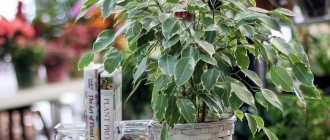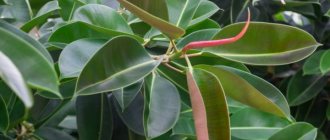Ficus rubber plant care at home
The unpretentious tree has long settled in the homes of domestic flower growers. You can often see a luxurious evergreen plant in the walls of offices. Minimal care is sufficient for the green giant, and it enjoys continued popularity. In addition, ficus perfectly purifies the air from various types of harmful impurities. Among them are formaldehyde, benzene, phenol, trichlorethylene. The useful plant is also a real green healer. It is used in the preparation of medicines for various diseases. Ficus rubber care at home is the topic of the article for everyone who wants to enjoy the excellent health of this handsome indoor plant.
Is it possible to prune the rubber ficus?
Pruning rubber ficus is needed not only to make the tree decorative, but also to improve the health of the plant. It is necessary to remove excess shoots regularly so that it is healthy, lush, leaves and stems have enough space to grow, and all above-ground parts of the bush receive enough light and humidity from the air.
Removal of branches is also carried out for sanitary purposes - diseased, rotten, dry, broken branches draw out nutritional components, taking them away from healthy parts, and can also reduce immunity and cause diseases.
With the help of formative pruning, ficus can be forced to branch or grow compactly. The florist himself determines what crown diameter is suitable for growing in rooms of different sizes.
Ficus rubbery description, photo
This perennial belongs to the Mulberry family. Its thick juice has long been used to produce natural rubber. There are about 900 species of ficus in nature. The rubber variety is an evergreen tree. The rough gray-green bark is dotted with small transverse depressions. The oval oblong leaves have an attractive appearance. They are glossy and hard. Young foliage is curled. It is covered with pink stipules.
The formation of the crown can be done in two ways - according to the principle of a bush or a tree. The rapid growth of this handsome indoor plant allows you to achieve the desired result relatively quickly.
Attention! This type of plant releases rubber into the air. This can cause an allergic reaction in household members or an attack in patients with bronchial asthma.
Features of the plant
The name rubber ficus is due to the fact that it has thick sap inside that contains rubber. Ficus, growing in nature, is revered by Buddhists as a sacred crop. It can grow up to 30-40 meters and expands well due to aerial roots. Because of these roots, locals call it the “snake tree.” The leaves of the plant are large, leathery and rich green in color. They are oval, tapering to the tip.
Flowering ficus rubber plant
Interesting!
In the old days, Ficus rubber was grown en masse to produce rubber.
The flowers are simple and not particularly beautiful. Flowering occurs if the plant is pollinated by certain types of insects, so it occurs when grown outdoors or in the garden. The fruits are almost round, up to a centimeter in diameter, and look like inedible figs.
Outside hot regions, rubber ficus is grown primarily as an ornamental plant. In apartment conditions, it rarely grows more than 200 cm. If the ficus has grown too large, you can always trim it, then it will stop growing upward and begin to grow leaves. But it’s worth considering that it rarely produces lateral pagons in indoor conditions, so it’s important to be able to shape it in order to get a beautiful crop.
Origin
The rubber plant is native to Southeast Asia. Or rather, the expanses of India, China, Sumatra and Java. The subtropical regions of these countries and islands are best suited for the plant to grow in natural conditions. This tree has been in cultivation since the beginning of the 19th century. It is usually grown in specially selected large flowerpots. The growth of the giant is limited precisely by the dimensions of the container.
In the natural environment, its height can reach 50 meters. With proper environmental humidity, rubber plants are able to develop aerial roots. They spread in all directions.
Ficus rubber at home
Traditionally, from October until the end of winter, the green pet rests - a period of rest begins. But by maintaining the required temperature, additional illumination with phytolamps and maintaining the required air humidity, the indoor beauty continues to grow and develop. This happens more slowly than in the summer months.
Location
A guest from the subtropics prefers to occupy a permanent place in the house. Does not tolerate frequent movements. It is better to immediately determine the green pet for the final position. He feels best near the window. But under no circumstances should drafts be allowed - this has a detrimental effect on the tree.
Lighting
Sunlight is needed in sufficient quantities. But it is better if he is absent-minded. Plants with variegated leaves are more picky about the level of illumination. Species with uniform coloration tolerate light shade more easily.
Attention! If the indoor beauty begins to lengthen the internodes, the growth of the stem slows down, or the leaves begin to fall off, these may be signs of a lack of sunlight. In winter, it is recommended to provide additional lighting using special phytolamps.
Watering
The rubber plant does not tolerate high substrate humidity. In summer, irrigation should be very abundant, but only after the top layer of soil has dried. In winter, watering should be limited. Be sure to pre-settle the water. It should be warm, room temperature.
Top dressing
During the active growing season, the indoor pet is fed twice a month. For this purpose, a special complex fertilizer is used for plants with decorative foliage properties. If rubber plants are grown using hydroponics, fertilizing is carried out constantly throughout the year. A particularly important component is nitrogen.
Trimming
Carrying out this event allows you to adjust the height of the green pet and give its crown the desired shape. The procedure also allows you to stimulate the growth of foliage in the lower part of the trunk.
It is recommended to start pruning in early spring. It is necessary to prepare a sterile blade and carry out all necessary manipulations with it. The milky juice on the cut should not be washed off.
If you trim the top in order to stimulate the development of side shoots, then this measure will not give the desired result. The green beauty will not branch in different directions. Usually several internodes are trimmed. When the maximum threshold of the desired height is reached, the shoots are shortened again.
Know! If, out of ignorance, the top of the rubber plant was cut off, it can be rooted and planted in a pot with an adult specimen to achieve the visual effect of the bush’s lushness.
Temperature
Since the homeland of this handsome indoor plant is the subtropics, it is very thermophilic. In summer, the temperature range comfortable for its growth ranges from 25 to 30 degrees. In winter, the desired values drop to 16 - 20⁰C. Do not overheat by placing the tub near the radiator of the central heating system. But overcooling on the windowsill is also not permissible. A sudden drop of leaves can be a reaction to cold weather.
Air humidity
It is preferable to maintain a high level of moisture in the surrounding space. To do this, the tree is sprayed every day. Sometimes it is necessary to “bathe” your green pet under the “shower”. Wipe the foliage weekly with a soft damp cloth to remove dust. From time to time, you can specifically polish the leaves using various wax-based products. Non-alcoholic beer, which is absolutely safe for your pet, is also suitable for these purposes.
Substrate
It is important that the soil has a slightly acidic or neutral pH reaction. Young growth prefers light soil. You can make a suitable mixture yourself. To do this, it is enough to take peat, sand and leaf soil in equal proportions. Adult specimens require a higher substrate density. The following homemade soil options have proven themselves well:
- one part each of turf and leaf soil, sand, and peat;
- sand and both types of earth in a ratio of 1:2:2;
- two shares of leaf soil and one each of peat and humus.
Ready-made purchased mixtures from bags intended for growing ficus or palm trees are also suitable.
Important! Do not forget about the formation of a drainage layer. Timely removal of moisture is very important. If desired, the flower can be grown hydroponically.
Signs and superstitions
There are quite a lot of signs and superstitions in the world that are associated with the rubber-bearing ficus. This flower, according to some sources, attracts happiness to the house, while others, on the contrary, say that it should not be kept in residential areas. This plant has special energy and influences its environment. The rubber-bearing ficus absorbs the spilled energy of people and cleanses the atmosphere in the house. To increase positive energy, the leaves of the flower should face west. At the same time, the atmosphere in the house becomes calmer, softer and more peaceful.
Ficus should not be placed on the northern, southern and central sides of the house or apartment. These zones do not allow the flower to reveal its energy abilities and contribute to the accumulation of negativity.
Among the signs the following stand out:
- If the ficus stands in a large room, then this promises happiness;
- the flower in the corridor stores the energy of the family;
- in the kitchen - to prosperity, money;
- in the bedroom - for the birth of children.
The flower can be placed in the kitchen, then no one in the family will go hungry, and there will be plenty of food.
Ficus growing in the bedroom has a beneficial effect on the course of pregnancy and will make childbirth easier. If it is not possible to get pregnant, then the flower is placed at the woman’s head. When a large number of young leaves and shoots appear, the young sprout is planted in a separate pot. You need to look after him like you would your own child. The likelihood of getting pregnant in this case increases.
Based on signs, it is not recommended for single women and married couples to keep the flower. In the first case, the woman will never meet her other half. Secondly, the couple will divorce.
On the other hand, this flower attracts money; it is planted by those who want to make good money or get rich quickly. The plant is best placed in an office or workplace; it promotes career growth, an increase in salary or lucrative deals.
Ficus rubber propagation methods
There are several ways to breed guests from the subtropics. To obtain “babies” you can use various parts of the plant:
- cuttings;
- layering;
- leaves.
Cuttings
It is the most popular method of reproduction. It's all about the reliability of the method. The workpiece from the shoot or top is cut at an angle of 45 degrees. The length of the cutting can vary from 10 to 15 centimeters. The leaves are removed, with the exception of only the top two.
The workpiece must be washed with running water until the release of juice stops. Then the shoot can be placed in a container of water and wait for the roots to appear. The leaves on the cuttings are twisted and secured with an elastic band. This allows you to reduce the area of moisture evaporation.
If you have to deal with a variety whose leaves have non-uniform “spots” in color, it is recommended to treat the cuttings with a root formation stimulator before planting. These can be various drugs - “Kornevin”, “Heteroauxin” or any other suitable remedy. In this case, it is advisable to provide the pot with bottom heating. This does not guarantee quick rooting, but it does promote root growth.
Know! Another rooting option is to plant the workpiece directly into the nutrient substrate. In this case, it is necessary to cover the shoot with a plastic bag on top. The film must transmit light.
By layering
Plants with spotted, variegated leaves are preferably propagated using this method. An incision is made on the trunk of the green beauty. Its depth should be one third of the diameter of the stem. To avoid the edges coming together, put a match into the cut. This section of the trunk is wrapped in moistened sphagnum moss and secured with film on top to ensure the proper level of tightness. You can secure the structure with tape.
When aerial roots appear, the shoot is cut off below the level of the layer with the root system and transplanted into the ground.
Leaf
Often, beginning amateur gardeners try to root leaves on their own, without a bud. At the same time, the roots do not slow down to appear, but the seedling obtained in this way does not take root. This happens due to the lack of a “growth point”. That is why for rooting it is necessary to choose a leaf with a piece of internode. This bud will subsequently be responsible for the growth of the bush.
Any plastic container is suitable for the rooting procedure. It is necessary to make drainage holes in the bottom and lay a layer of expanded clay or any other suitable material as drainage. Water should not stagnate in the pot.
Important! To speed up the process of root emergence, the workpiece must be washed to get rid of the milky juice. Its release slows down rooting.
The substrate should be airy and loose. You can mix commercial soil for indoor flowers with vermiculite. When planting, it is important to correctly observe the depth of immersion of the workpiece into the ground. The bud should be above the soil surface. You can strengthen the sprout by propping it up with a toothpick or a small stick.
After planting in a pot, the seedling must be watered abundantly. To create a greenhouse effect, the “baby” is covered with polyethylene on top. You can simply put on a transparent bag. In a few weeks, the seedling should have roots.
Pests, first signs
In summer, windows are often opened for ventilation. Ficus needs an influx of fresh air, but does not tolerate drafts. Pests can enter from the street and form a colony on the flower.
The attack of parasites is especially dangerous in the summer, when they are in their breeding season.
Spider mite
One of the most dangerous insect pests. The size of a tick does not exceed 1 mm, but most parasites are even smaller, so they are difficult to notice immediately. Mites form thin webs to move between leaves, on the underside of which eggs are laid.
To exterminate spider mites, one treatment is not enough, since only mature adults die. Then new parasites hatch from the eggs and the problem does not disappear.
Ficus trees are especially susceptible to mites, so you can use acaricidal preparations and folk remedies at the same time - Fairy dishwashing detergent solution, hogweed tincture, basil, tea tree oil. The most environmentally friendly method is to use predator mites against their spider relatives. In a short time, one species eats another, including its unhatched larvae.
Shchitovka
Novice gardeners often confuse scale insects with growths on shoots, but at this time the parasites are already sucking the juices out of the plant, compromising its immunity.
Scale insects leave wounds that become infected - bacteria and fungi. This is one of the reasons why the ficus turns yellow and then drops its leaves.
How to get rid of:
- Clean the shoots with a toothbrush.
- Wash the ficus with hot water ( 50 degrees ). This will cause insect tissue to burn, making it easier to remove.
- Wash the shoots with soapy water.
- Treat all parts of the plant with Aktelik.
Ficus pests will be forced to retreat after such a counterattack.
Video: Ficus turns black - what to do
Ficus rubber transplant
Young animals need to be moved to a different container every year. The most suitable period for holding this event is the spring months and the beginning of summer. Adult trees are replanted as soon as the roots fill the entire volume of the pot. This usually happens every two or three years.
If, when watering, the water quickly leaves the flowerpot, it’s time to replant the green pet. Each subsequent container should be 5 centimeters in diameter larger than the previous one and the same amount deeper than its predecessor.
Important! If the ficus is already old and replanting it is dangerous, it is enough to simply annually change the top three-centimeter layer of substrate in the tub with fresh one.
To move to another container, the bush is taken out along with a lump of earth and transferred to a new container, where a thick drainage layer has already been poured. Empty spaces are carefully filled with fresh substrate. And so on to the very top of the flowerpot.
What kind of pot does a rubber ficus need?
Young animals will feel comfortable in large pots. They can be made of plastic or ceramic. Adult specimens require spacious tubs. Their volume must exceed 10 liters. Following the advice of experienced gardeners will help you choose the optimal container for growing a green pet:
- In terms of shape, a model with equal height and diameter measurements is considered suitable.
- The size of the flowerpot is directly proportional to the dimensions of the root system. There should be at least two centimeters of free space between it and the walls of the pot. If the container is chosen incorrectly and significantly exceeds the required dimensions, the plant may simply rot and die.
- Young animals up to one year old will be comfortable in a flowerpot made of clay without any decorative coating. For older bushes, tubs made of wood, plastic or ceramic are equally suitable.
Attention! The material from which the pot is made must be inert and not react chemically with the soil.
Prevention of ficus diseases
The new seedling is isolated for at least 7 days in a separate room. If after quarantine no signs of disease are found, then it is placed with the rest of the plants. To prevent the development of diseases, it is recommended to examine the ficus daily for uncharacteristic external changes. It is not advisable to place pots close to each other. After transferring or replanting flowers from the garden to the house, their leaves should be wiped with a solution of laundry soap.
Attention! Do not buy ficus trees with damaged or limp leaves. A sick plant will not be able to adapt to a new location and will quickly die.
Experienced flower growers advise regularly cleaning trays and pots, not overwatering or overfeeding the plant, monitoring the level of humidity and air temperature in the room, and also not placing flowers under the scorching sun. Disinfection of soil prepared independently or purchased in a store is carried out using a weak solution of potassium permanganate. Treating the ficus with a fungicide solution, copper oxychloride and cuprosan will get rid of the fungus. Any insecticide will work against insects.
To increase the resistance of ficus to external harmful factors, use Epin and Zircon. In severe cases, it is necessary to replace the soil and replant it in a new pot with pruning of the affected areas of the stem and rhizome. The sections are dusted with charcoal powder. From March to September, once every two weeks the soil can be fertilized with magnesium sulfate, Potassium Mag, iron chelate, Ferovit, dolomite, or fed with Emerald leaf fertilizer.
Ficus rubber diseases and pests (treatment)
The tree is relatively resistant to various diseases and is rarely attacked by pests. But sometimes scale insects and spider mites cause harm to the green beauty. To combat them, tobacco infusion is suitable. Four large spoons of powder are stirred in a liter of water and a little grated laundry soap is added. The mixture is applied to the leaves. After two hours, the solution is washed off.
If affected by scale insects, manually remove all insects from the foliage. To do this, use a cloth soaked in a solution of laundry soap. It is important not to spill it on the ground, so as not to destroy the flower. The tree is left to dry in a warm place. Then the foliage is sprinkled with tobacco dust. The main signs of a pest are a sticky coating and a distinct smell of rot.
If the top of the leaves are covered with a specific silvery coating, and characteristic reddish bumps appear on the reverse side, this is a thrips attack. In this case, careful treatment of the bush with Aktara will be required. Take 4 grams of the drug per 5 liters of water and spray the plant. The soil is subsequently watered with the same solution once every five days.
Fungal diseases can cause yellowing of leaves. The Cercospora fungus appears in the form of black spots, then yellowing of the leaf occurs, accompanied by a process of wilting and falling. Various fungicides are used as treatment. They treat the bush and inspect neighboring specimens. They are also at risk.
Attention! Keeping the leaves clean is the key to your pet's health.
Yellow spots mixed with a hint of rust indicate the presence of another fungal disease - botrytis. The spots grow and the ficus dies. Remove the affected shoots and treat the green pet with a fungicide solution.
Small white spots on leaves. Types of diseases of indoor plants
Indoor flower crops are susceptible to various diseases. For example, a white velvety coating may appear on the leaves or buds. This is a disease called powdery mildew, which is caused by a special type of fungus. The development of the disease is promoted by stagnation of water, a sharp decrease in temperature and irregular watering. The affected leaves need to be removed, the temperature and watering regime adjusted, and the crop itself should be treated with a fungicide (three times with an interval of 10 days).
The most common diseases include (Figure 1):
- Mycosis (gray rot) causes the formation of mold, after which the leaves simply rot. The disease appears when there is an increased level of humidity, too dense housing and insufficient ventilation. You can fight mycosis with fungicides only if the lesions are small. But most often the flowerpot is simply thrown away.
- If the leaves are covered with black soot, which quickly forms a crust, this means that the crop is damaged by black. Plaque does not directly harm, but spoils its appearance and interferes with photosynthesis. There is no point in fighting plaque with fungicides. The only way to eliminate it is to regularly wipe the leaves or rinse them in the shower. You can use a weak alcohol solution or beer.
- Late blight is also caused by fungi. Stems and leaves become covered with purple-brown spots, wither and gradually die. The disease can be provoked by too intense watering or a dense substrate. It is useless to fight late blight, and the affected specimen is simply thrown away along with the substrate. To prevent the appearance of the disease, flowerpots should be planted only in a specially prepared soil mixture, and in winter the room should be regularly ventilated.
Why do ficus leaves fall off?
If the plant gets rid of only the lower leaves, this is a natural biological process. Otherwise, you should correctly determine the cause of this problem. There may be several options:
- Excess moisture in the soil or excessively dry substrate. If the reason lies in improper watering of the pet, irrigation should be carried out moderately. The bush is covered with film to create the effect of a mini-greenhouse. If the soil in the pot remains waterlogged despite all efforts, the tree is replanted.
- Lack of sun rays. In the absence of natural light, the plant can be provided with artificial lighting.
- The presence of a draft in the room, especially a cold one. The green beauty cannot tolerate sudden changes in temperature. If not properly cared for, rot may develop. Not only does the foliage get rid of, but there is also a clear softening of the stem, and liquid continuously flows out of it. It is not possible to save such a plant. It needs to be thrown away urgently and the space where the pot was located must be thoroughly disinfected.
- Incorrectly performed transplantation. It is recommended to water the soil with Zykron. The concentration of the product is four drops per liter of water. Keep the soil moist. The same treatment is appropriate for problems caused by errors in the irrigation mode.
- The air is too dry. This may be one of the reasons for the sudden loss of foliage. Since this often happens after turning on the central heating system in the autumn, it is best to spray the leaves or install a humidifier as a preventive measure.
To speed up the process of development and growth of new leaves, your green pet can be treated with Epin solution (2 drops per liter of water). Spraying is carried out once a week and always at night. After all, under the influence of sunlight, the product rapidly loses its properties. Treatment is carried out for a week, followed by a break of the same duration. Then the course can be repeated.
If no measures have had the desired effect and the ficus is in a deplorable state, it is worth digging it up and checking the condition of the root system. Rotten, wrinkled or dry branches are removed to a healthy area. The sections are dusted with charcoal powder. You can also use activated. The pet is moved to a smaller pot. The substrate is completely replaced with a new one.
Know! Even if the indoor beauty is left completely without foliage, it will be able to recover. Proper care will save the situation.
What to do?
In winter, when cold weather sets in, the plant's leaves may curl. This is a normal phenomenon, since the flower senses the change in weather, even if the room is warm enough. But too much leaf loss is associated with other reasons:
- improper care;
- parasitic pests;
- various diseases.
Curling of ficus leaves is the first sign that the flower is dying. The main thing is to figure out in time what contributes to this.
- If it is a fungal disease, it is necessary to treat it with antifungal drugs.
- Improper care - look for signs of the ground part. Provide the plant with comfortable lighting, fertilize it with potassium and follow the watering schedule.
- And if the cause of the ficus disease is insect pests, first of all, you need to get rid of the parasites. Then treat the plant with special means.
If you do not adhere to the above tips and do not take action in time, the ficus may die.
Possible growing problems
Often, improper care causes the tree to feel unwell. Based on your pet’s appearance, you can determine the cause of his illness and correct the mistake in time:
- If reddish spots are found on the foliage, this does not indicate the presence of a pest. But it is a signal of a burn caused by direct sunlight. The likelihood of such a problem occurring after spraying is especially high. You just need to shade the green pet a little - and he will get better. It is important not to plunge it suddenly into darkness - light is vital.
- The leaves are deformed. This is not a symptom of any illness. Simply the plant's reaction to a stressful situation caused by setting a bud. If you maintain a high level of care, the deformed leaf will become a “point of intensive growth.”
- Not the entire surface of the sheet is deformed, but only its edges. This sign indicates problems with the root system. The problem may be caused by excessive waterlogging of the soil as a result of intensive irrigation. The solution is to significantly reduce watering. The plant is covered with a “greenhouse”. Another reason may be improper implementation of the transplant procedure. In this case, treatment with “Kornevin” will be effective.
- Red spots on leaves with drying tips are a sign of exposure to a cold draft. The plant is moved to a safe place. Watering is carried out very moderately.
- Young leaves grow not green, but brown. This is not a problem, but just a biological feature of the ficus. Improved care is required.
Conclusion
Wanting to get a beautiful and healthy plant, every amateur gardener, when purchasing a rubber ficus, must remember how to care for it at home.
Fungal and other diseases
If the leaves begin to fall in the fall, there is no reason to worry. This is completely normal. However, there are other reasons that negatively affect the growth of ficus.
- Root rot is caused in two ways: poorly drained soil or too frequent watering. Any of these situations will cause the roots to begin to soften and rot. The problem can be prevented very simply by adjusting watering control and organizing high-quality drainage.
- Phomopsis canker is caused by pruning with a non-sterile instrument. This fungal disease enters the plant through cuts. The easiest way to combat this is to completely cut off the affected branch, since there are no chemical treatments for this disease on the market.
- Ficus plants sometimes attract fungal pathogens that cause crown rot or stem rot . It attacks the plant from the ground line, causing the crown to rot and the leaves to yellow, wither and even die. High humidity contributes to the appearance of a white coating on the soil and stems. Brown spots and sometimes gray mold appear. Spraying healthy foliage with a mancozeb-based fungicide will help.
Most bacterial diseases cannot be treated, so the plant is completely destroyed. Good care can prevent infection. A simple set of fertilizers, applied on time and in the required quantity, helps to revive a plant if it is not growing well.
To learn how to deal with ficus benjamina pests, watch the following video.
Ficus diseases
develop due to improper care, various infectious diseases and due to infection with fungal spores. No less harmful are ficus pests, which feed on plant sap and gnaw passages in the veins of the leaf and stem. Some insect larvae poison the root system with their poisons. The flower begins to wither. The foliage changes color and becomes spotted, dies and stops growing. Later, the roots rot and the plant dies.
Ficus does not tolerate leaf diseases well, but can recover, like any plant, if the cause of their modifications is noticed and eliminated in time. It is also characterized by very specific features of a change in appearance, not related to the activity of pathogenic micro- and macroorganisms. Common diseases and problems of ficus are described below.










